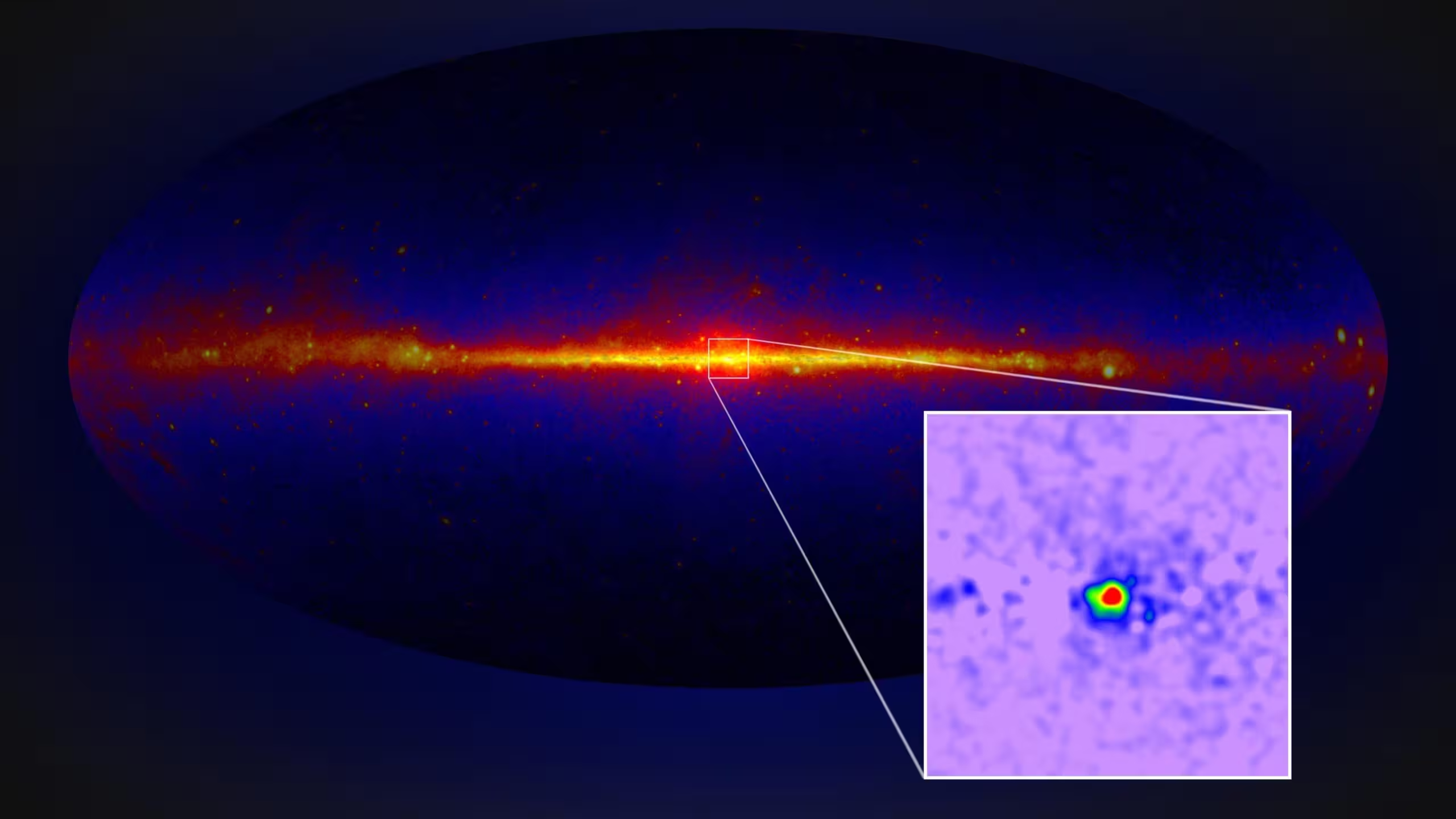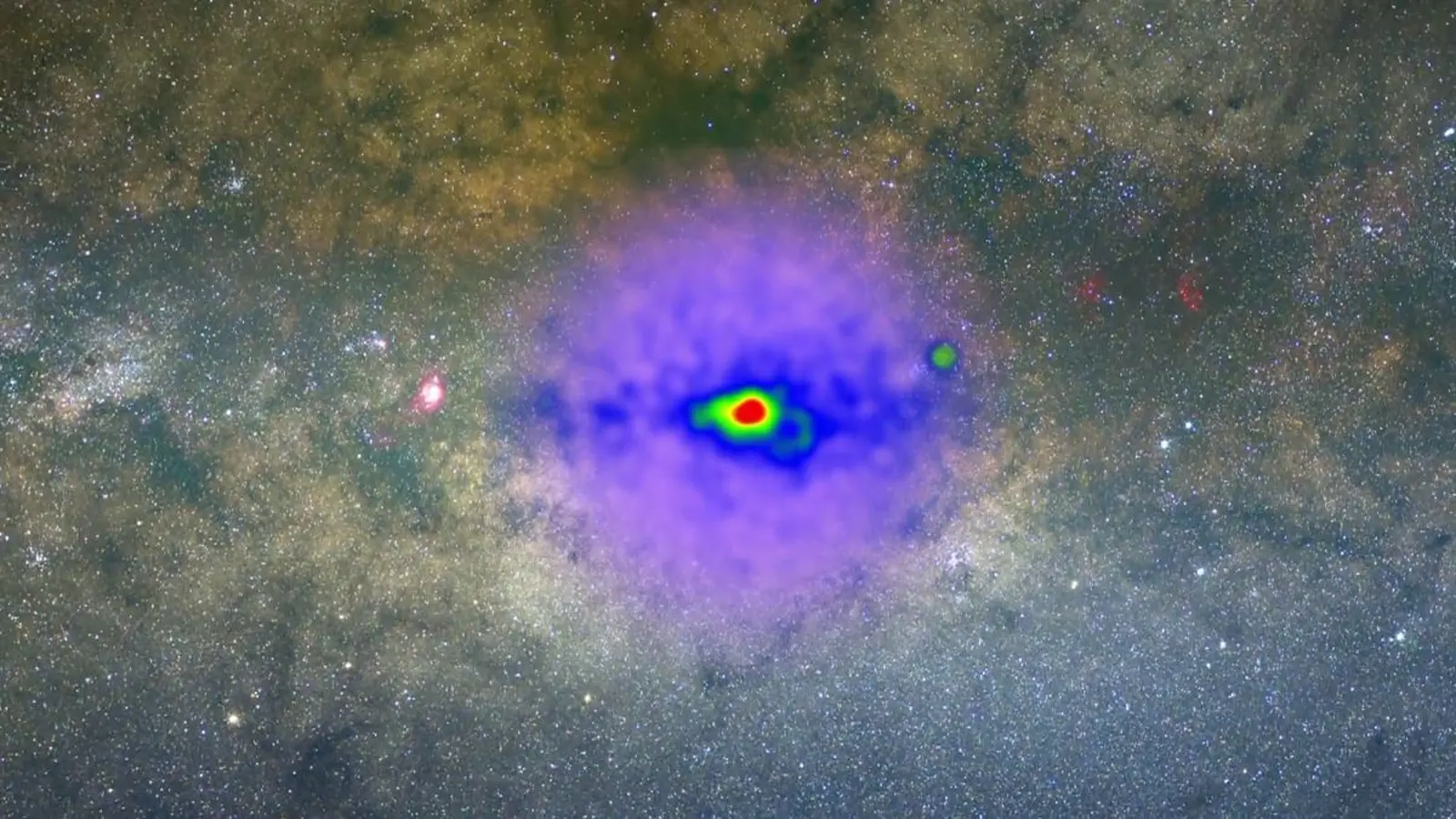6 Minutes
A persistent gamma-ray glow around the Milky Way’s center has baffled astronomers for more than a decade. New galaxy-scale simulations suggest the light could be the long-sought signature of dark matter annihilation — or it may still come from a hidden population of rapidly spinning neutron stars called millisecond pulsars.
Why the Galactic Center GeV Excess matters
Since 2009, data from NASA’s Fermi Gamma-ray Space Telescope have revealed an unexpected surplus of high-energy gamma rays near the Galactic Center, a feature researchers label the Galactic Center GeV Excess (GCE). Gamma rays are the Universe’s most energetic light, and whatever produces the GCE must be powerful or abundant enough to light up the inner few thousand light-years of our galaxy.
Two hypotheses have dominated discussion. One posits that the glow comes from dark matter particles — possibly weakly interacting massive particles (WIMPs) — annihilating each other and producing gamma rays as a byproduct. The alternative points to an unresolved population of millisecond pulsars: tiny, extremely dense neutron stars spinning hundreds of times per second and emitting beams of radiation that include gamma photons.
Pinning down the origin has profound implications. If the signal is from dark matter annihilation, it would be the first non-gravitational detection of dark matter and a major breakthrough for particle physics and cosmology. If the culprit is pulsars, the result shapes our understanding of stellar evolution and the population of compact objects in the Galactic bulge.

New simulations test shape and origin
To tackle the debate, a team led by cosmologist Moorits Mihkel Muru at the Leibniz Institute for Astrophysics Potsdam ran high-resolution simulations of Milky Way–like galaxies. The study reconstructed how the dark matter halo and the old stellar bulge could look today after billions of years of mergers and internal evolution.
Previous observational work suggested a morphological clue: the spatial distribution of the GCE appeared “boxy” — an X-shaped bulge signal similar to the distribution of old stars in the Milky Way. If the excess strictly traced that boxy distribution, millisecond pulsars concentrated in the bulge would be the obvious source. A dark matter halo, in contrast, had been assumed to be roughly spherical, which would produce a smoother, rounder gamma-ray profile.
But the simulations changed that straightforward expectation. The team found that the Milky Way’s dark matter halo is likely not perfectly spherical. Repeated mergers and dynamical effects over cosmic time can flatten and distort the halo. When projected from the Solar System’s vantage point — roughly 8 kiloparsecs from the Galactic Center — a slightly flattened dark matter distribution can appear boxy on the sky, much like the stellar bulge.
In other words, halo shape alone may not conclusively discriminate between dark matter annihilation and a population of millisecond pulsars. According to the researchers, both origins remain plausible based on morphology, spectral energy distribution, and intensity — though they give a mild edge to dark matter when accounting for the current shortfall in detected pulsars.
Texture, point sources and mixed scenarios
Not all evidence points the same way. Some analyses of Fermi data have found small-scale speckling within the GCE that looks like individual point sources, consistent with millisecond pulsars. Dark matter annihilation would produce a smoother diffuse glow. This new paper focuses on large-scale shape and does not directly resolve the small-scale texture issue, which other studies continue to debate.
That ambiguity opens the possibility of a composite origin: a smoother component from dark matter annihilation combined with contributions from unresolved pulsars. Distinguishing these possibilities requires better angular resolution, deeper sensitivity to faint point sources, and multiwavelength follow-up that could identify pulsars in radio or X-rays.
New telescopes will help separate the signals
Upcoming observatories should sharpen the picture. The Cherenkov Telescope Array (CTA) in the Northern and Southern hemispheres and the Southern Wide-field Gamma-ray Observatory (SWGO) will probe higher-energy gamma rays with improved sensitivity and angular resolution compared with current instruments. These facilities can test whether the excess has a smooth spatial profile or resolves into many faint sources, and they will probe spectral features expected from different annihilation channels of WIMPs.
If CTA or SWGO detects the characteristic energy spectrum and spatial smoothness predicted for WIMP annihilation, it would lend strong support to a dark matter interpretation. Conversely, finding numerous faint gamma-ray point sources concentrated in the bulge, or identifying many millisecond pulsars at other wavelengths, would favor a stellar-origin explanation.
Expert Insight
“This study underscores how complex galactic archaeology can be,” says Dr. Elena Vargas, an astrophysicist who studies gamma-ray sources. “Dark matter halos are products of a galaxy’s entire merger history, and that history can erase the simple spherical picture. What matters now is combining morphology with spectral fingerprints and direct searches for pulsars at radio and X-ray wavelengths.”
“Imagine looking at a distant city at night: from far away you might see a glow, and only with better lenses do you resolve whether it’s a diffuse lamp or dozens of streetlights. The next decade of gamma-ray observatories should give us those lenses,” she adds.
The debate over the Galactic Center GeV Excess illustrates the interplay between cosmology, high-energy astrophysics, and stellar population studies. Whether the glow turns out to be dark matter self-annihilation, a hidden cluster of neutron stars, or both, the results will refine models of the Milky Way and potentially open new windows onto fundamental physics.
Source: sciencealert
Comments
Marius
Is this even solid? speckles point to pulsars, shape favors DM, idk maybe both. need better eyes, CTA pls
astroset
wow ok this is wild, dark matter looking boxy? mind blown... also kinda poetic, hope CTA clears it up lol


Leave a Comment